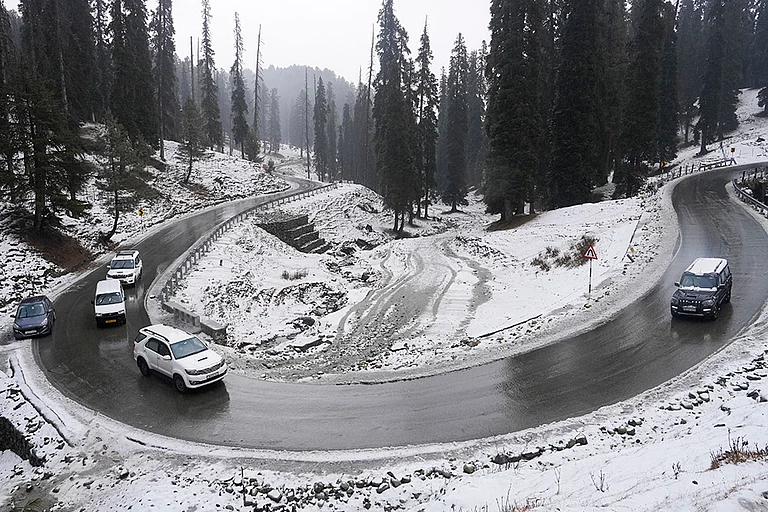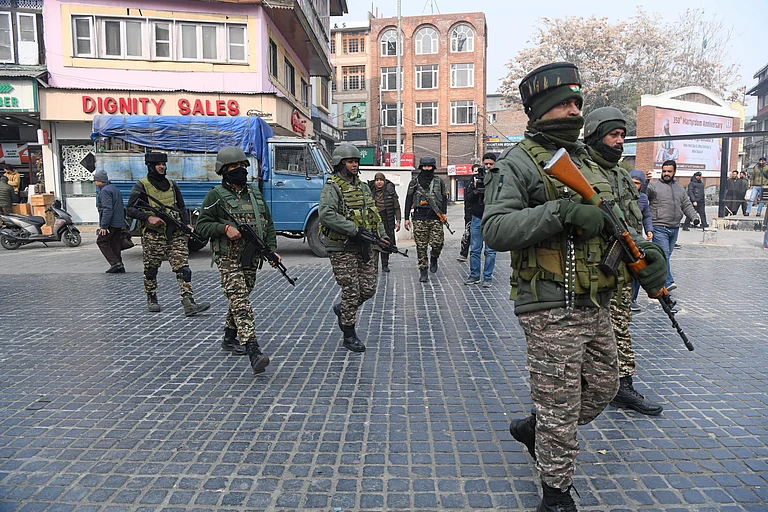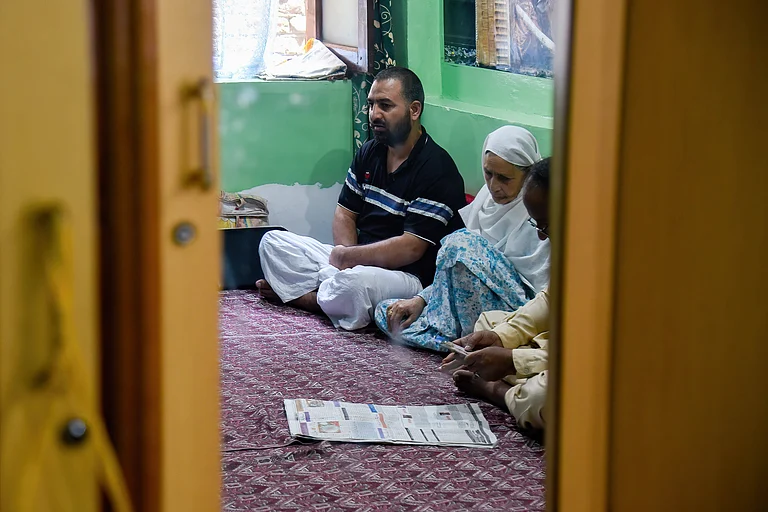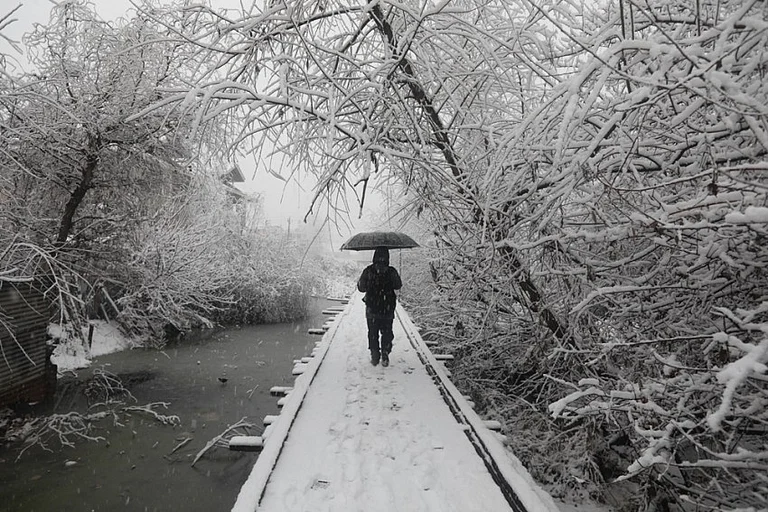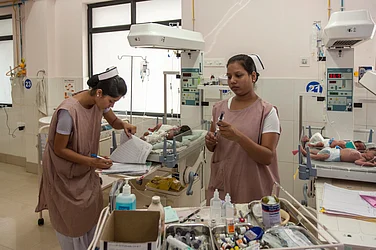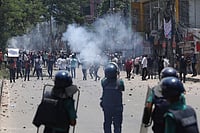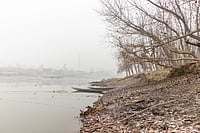
In Kashmir, a few days of rainfall leave people on edge as the authorities have failed to ensure safeguards against the floods.
The 2014 floods resulted in the loss of 304 lives and damaged over 2.4 lakh structures across Kashmir.
Chief Minister Omar Abdullah observed that lessons from 2014 were ignored and actions to prevent recurrence remain unclear.
The Jhelum River was in its flood spate, and when the water rose into their houses, the local residents fled. Over twelve days after the Karnabal area in South Kashmir's Samboora was flooded, the ruins were visible all across. Banks of the river, which were lined by a windbreak of poplar trees, had been torn by the deluge. A brick mosque was being cleaned from the muck that caked its concrete floor, and the mounds of sand that had been gathered from the river to be sold by the people for living were all washed away. A concrete bridge that connects the Karnabal with the Kakapora area of Pulwama had been deserted when the water rose, but now the boats used for ferrying people across the wide river stood empty. A group of labourers hauled up the sand from the river, recalling the fear that had taken hold of them when the water engulfed the place, forcing people to abandon their homes.
In Kashmir, after a few days of rainfall, the residents along the banks of the main river Jhelum, lived on the edge. In 2014, the water level in the Jhelum River breached the danger mark, contributing to the floods. Nearly 11 years later, the fear of the floods returned to people living in the plains and banks of the Jhelum and some streams after a brief spell of rainfall. In 2014, the rainfall from August 28 to September 10 caused floods in Srinagar and various districts of Jammu division, resulting in the death of 304 persons and damage to over 2.4 million structures, including houses.
This time, however, the fears have risen as the authorities have not taken sufficient measures to safeguard the lives and property of the people. No dredging has been carried out in the Jhelum River over the last five years, which was believed to be one of the key means of preventing floods, while encroachments in the Jhelum catchment and several streams have continued unabated. While there was no loss of life, the floods this time caused extensive damage to agriculture and horticultural crops.
Fear in residential colonies
When the water level rose in the Jhelum at Karnabal, residents panicked and quickly began collecting whatever they could to move to a safer area. Aijaz Ahmad Dar, 35, a local resident, says that the water level was high, and the ground floor of most houses was submerged, some five to six feet underwater. “We thought we would drown in the floods, and when the water flowed into our mosque and the houses in the afternoon of September 3, we collected whatever little we could to move to safer places. Our family relocated to Chandhara, which is five kilometres from our house, and remained unaffected by the floods. We returned only a few days later when the water had receded,” says Dar.
The situation was no better in Srinagar district and other parts of South Kashmir, where people remained on edge as water flowed into residential areas. Mehraj-ud-din Bhat, a resident of Zainakote, says that water flowed into several residential colonies due to a breach in an embankment in the Hokersar wetland. “The situation was as grim as it was during the 2014 floods. Due to a weak embankment, the houses were submerged several feet under water.” Several residents of the Kakapora area in Pulwama, who live close to the Romshi nullah, reported that the water submerged their apple orchards and paddy fields, causing extensive damage.
Poor flood safeguards
In 2014, when the floods swept most of the Srinagar district, authorities developed a plan to dredge the Jhelum River to increase its capacity and vowed to construct an alternative flood channel from Sangam to Wullar Lake. The issue of tardy relief efforts by the NC-Congress government, led by Chief Minister Omar Abdullah, became a key electoral issue. Following the floods, Omar lost power to the coalition government led by the PDP-BJP alliance in the erstwhile state of Jammu and Kashmir. After the floods, Omar, while reviewing the evacuation measures, said that no lessons had been learnt from the 2014 floods. He said that there are questions about what was done after the 2014 floods in Kashmir, and those “who were ruling here have done nothing that would have ensured floods do not recur.”
The government has acknowledged that no dredging work has been done on the Jhelum River or its flood spill channels in the Kashmir Valley over the past five years, as confirmed by the Irrigation and Flood Control department in response to an RTI filed by activist M. M. Shuja. The RTI reply also revealed a slow pace of removing encroachments near the Jhelum and in Srinagar, Pulwama, Baramulla, and Anantnag.
Shuja criticises the authorities for poor performance in removing silt from the canals and dredging the Jhelum. He says, “The authorities claim to have desilted irrigation canals, but there has been no dredging of the Jhelum. After just a few days of rain, there is flooding.”
Advocate Nadeem Qadri, an environmental lawyer, states that there has been a violation of the master plan in the construction of the buildings, and encroachments in flood-prone areas have exacerbated the situation. “Buildings have been constructed in the flood-prone zones, and the government response has been shoddy. No environmental assessment has been done before constructing infrastructure projects, which is responsible for the catastrophes like the floods that have been witnessed,” he adds. Qadri urges the authorities to immediately enforce the master plan guidelines, conduct thorough environmental assessments, and take concrete steps to remove encroachments in order to prevent further disasters.
Chief Engineer Showkat Hussain says dredging was stopped following Central Water Commission recommendations, but the government is considering dredging the 50-kilometre flood spill channel from Padshahi Bagh in Srinagar to Wular Lake in Bandipora. He notes that several structures, such as bridges built by various government departments, will be affected. "We have sought Rs 300 crore from the government for dredging the existing channel, which can carry 20,000 cusecs of water and is 100 metres wide. The government is also considering a similar channel from Sangam to Bandipora to boost flood infrastructure," he says.
Focus on Evacuation, Alerts
Officials of the Irrigation and Flood Control department say desilting and dredging are not permanent flood prevention measures, and they are working to improve alert mechanisms to ensure better evacuation during rising water levels. They acknowledge a significant encroachment of the Jhelum flood basin, which has caused damage to public infrastructure due to inundation in the past and again this time.
An official cites the poor flood management currently in place. Officials say constructing an alternate flood channel from Sangam to Wullar Lake to drain the Jhelum of excess water is a distant possibility due to high costs and the large-scale displacement of residents. An official also states that releasing water from Dal Lake to maintain Jhelum’s level is difficult. This measure, intended to curb floods, is limited: “There is a level to which water can be released in Dal Lake; it can be done only to the extent of two to three feet, as releasing excess water loads the lake with silt, threatening its ecology and the lives of dwellers,” says the official. Earlier, as Jhelum River levels rose, authorities breached Kandizal in Pulwama—a step described by the government as “a desperate and ultimate attempt to avert danger to the urban areas of Srinagar city.” However, this breach also left several villages submerged in water.
Residents in South Kashmir say that due to a lack of arrangements to drain water from local streams, they are increasingly vulnerable to flooding. Mehrajudin Lone, a resident of Kakapora, states that after the breach in an embankment caused by the overflowing water from the Romshee nullah, they suffered massive damage to their horticulture and agricultural crops. “An alternate channel to ensure the discharge of flood water from the Romshi nullah can help us overcome losses,” says Lone.
Mehraju din Bhat says authorities must desilt the Hokersar wetland flood channel and raise the embankment to prevent floods. He urges immediate action: “Such measures are necessary to prevent further loss of life or property.” The time for inaction is over; authorities must act swiftly to implement these solutions







